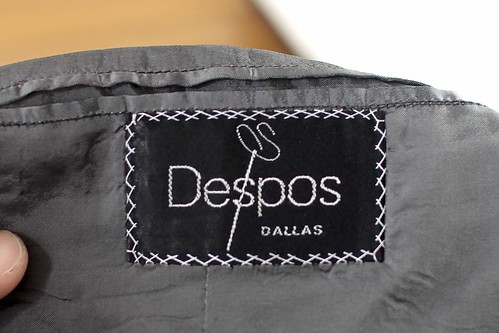
In the world of tailored clothing, there are houses that are, in my opinion, seriously overhyped, and others who deserve a lot more attention than they get. Chris Despos falls into the latter category.
Based now in Chicago, Chris once operated out of Dallas, a city he frequently travels to, in addition to others, so if you are looking for one of the country's (perhaps one of the world's) top tailors outside of the Manhattan area, you can find him in his Oak Street studio.
Many thanks to Chris for donating this suit to science.
One of the first things that sets my bells ringing is this shoulder.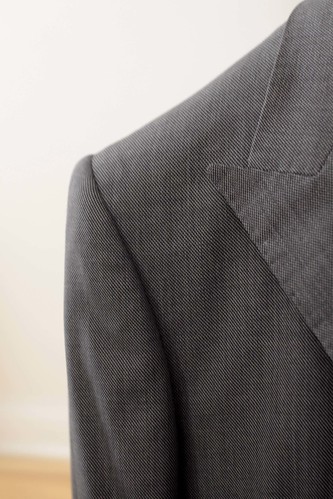
Though currently out of favor but perhaps enjoying a return of sorts, one of the reason that this type of pagoda-shaped shoulder is not so commonly seen is that it represents the pinnacle in terms of difficulty of execution. In other words, it may look odd to many people because they are not used to seeing it because so few can do it right. This kind of shoulder goes beyond just aesthetics- it is actually made to conform more naturally to the actual shape and forward pitch of the human shoulder, and there is a great 3-dimensionality to it. In movie terms, this shoulder is the Avatar to so many Creatures From The Blue Lagoon. You'll be able to see what I mean a bit later in the post.
This suit was made back in 1992 but as we saw in a previous post, has held up really well despite its being made in a super 150s cloth. Chris will be annoyed with me when he sees that the coat has been sitting in a heap since my last post and is thus in need of a pressing, but another annoyed reader commented that they wanted to see more of the garments than just the guts.
Some buttonhole porn, for those who are into that. These buttonholes are gimped with a single strand of buttonhole twist, instead of the type of gimp I use, so readers who are experimenting with buttonholes and don't have access to the Agreman gimp, here is proof that you can get perfectly good results without it.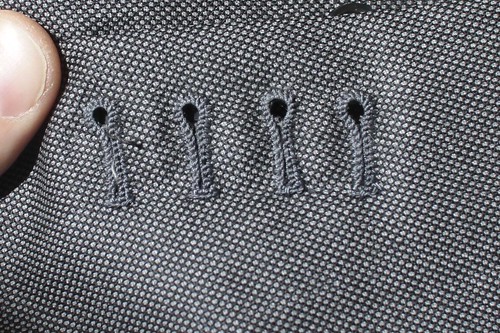
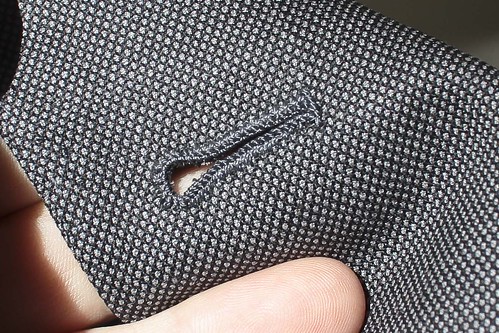
Here's something we don't see all that often anymore; the outlets and cut edges have all been pinked (cut in a zig-zag edge). This prevent the edges from fraying, especially the lining which can get really messy, and may also help to prevent seam impressions.
The sleeve head wadding is of the Kotex type, but this has not disintegrated at all. In addition, a single, bias-cut piece of canvas reinforces the front of the sleeve.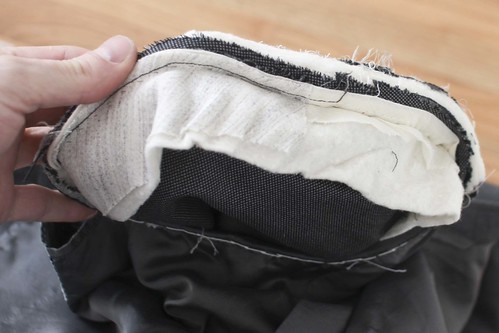
The back of the scye has been stayed with a piece of lining which has been backstitched by hand.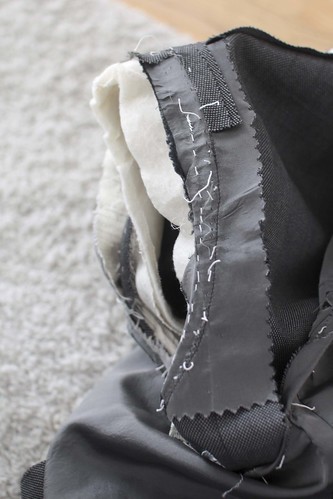
An extra strip of self cloth has been inserted at the cap of the sleeve for smoother pressing.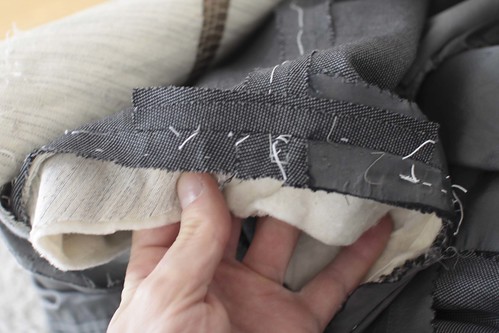
Though it doesn't show in photography, it is worth noting that the sleeves (which are very large, thank you) have been sewn into the (very small) armhole BY MACHINE. The shoulder seam has likewise been sewn BY MACHINE. I don't think that these two steps need to be done by hand, and here is an indication that neither does Despos (nor does Henry Poole, for that matter). His opinion on the matter may since have changed and if it has, I am sure he will share it with us.
A full view of the coat front shows that his chest piece is of a moderate size, and has been worked up by hand. 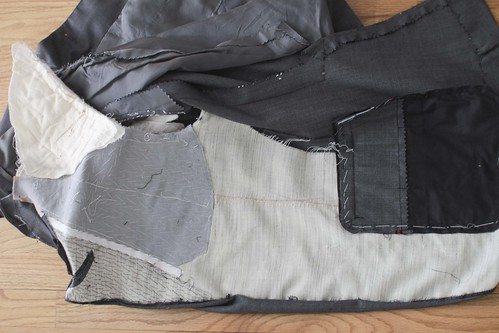
A closer look shows some of the cuts required to shape the shoulder.
And now for a better look at what I mean about this shoulder shaping.
The pocket that has been created for the shoulder bone is very obvious here. This room is very important to the comfort of the garment- garments whose weight sits on the shoulder point are uncomfortable and don't move as well with the wearer. For this reason, shoulder seams which angle backward (and thus make it more difficult to get this forward pitch of the shoulder) are counter-productive, in my opinion.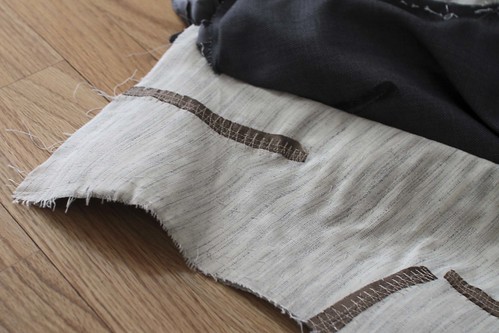
Even after 20 years, this shoulder has maintained its shape.
Inside the chest we see the various cuts in the haircloth which build shape, and a strip of beige silesia covering the roll portion to prevent the hair sticking through.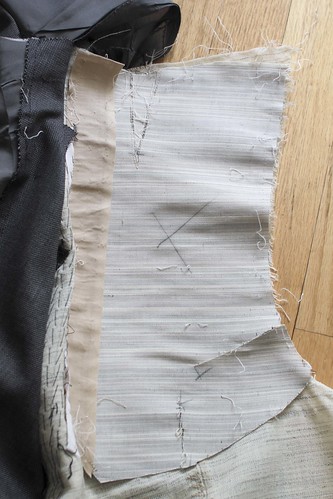
A bias-cut shoulder piece is found, as expected, but somewhat unexpected is the hairline; I am more accustomed to seeing it running up toward the outside of the shoulder, but whatever works...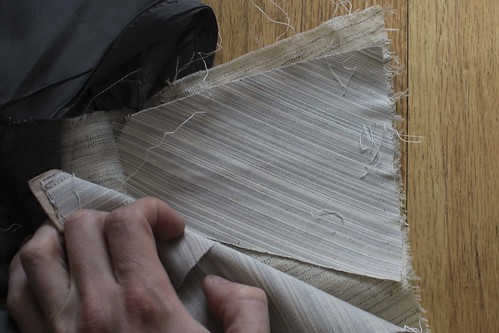
A piece of weft-insertion fusible is used to stabilize the bias grain of the peak lapel.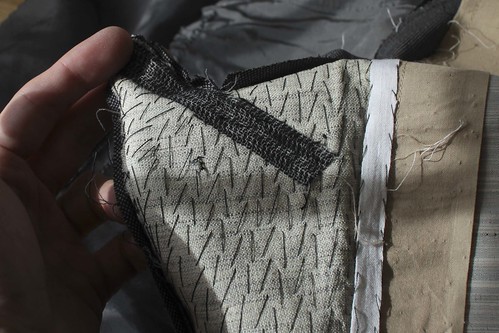
The lapel itself feels a little meatier than I expected so I rip some of the padstitching to have a look underneath. Sure enough, more weft-insertion under the lapel to give more volume to the roll.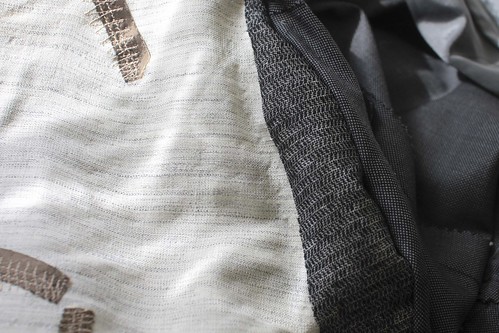
I won't dwell too long on the pants, other than to say their execution is some of the neatest I've seen from the many examples of bespoke work. A few details of note, though, are the buttonhole-stitch bartacks at the end of the pockets,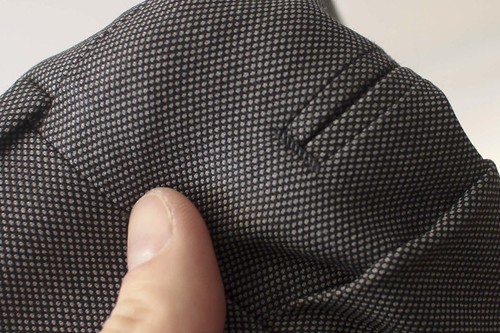
Waistband extensions are more commonly square, as they are much easier to finish than the rounded type, as this one which requires much more work and precision.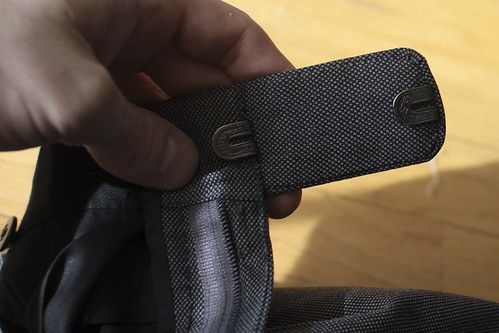
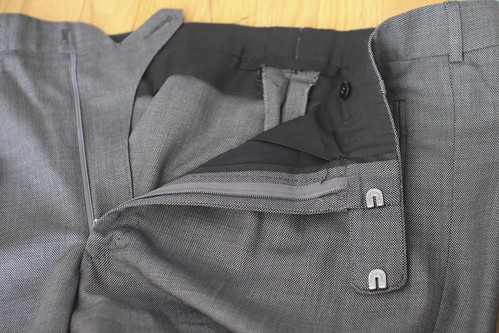
My general impression is that this garment is neater than the majority of examples I have seen from Saville Row houses, and in many instances, more care has been given in its execution. More work went into this garment than the Caraceni that we saw, and the house is legendary. So while the name may not carry the same appeal or cachet than some of the other, more famous houses, the level of workmanship takes a backseat to none of them.
EDIT- disambiguation. There are a number of different results when googling Despos, so to be clear, this is Chris Despos, who is located at 34 East Oak Street, Chicago, Illinois- contact me for the phone number or email address if you need it.








7 comments:
Splendid dissection, Jeffery. Time was Chicago had a fair share of custom tailors in the last century, some of whom did very fine work. Thank heavens we have Chris Despos to carry on the tradition of truly superb design and workmanship. It takes no great effort, other than deep pockets, to fly to London and commission a bespoke suit from Huntsman or Poole, but when the local talent is topnotch why bother? A relatively short drive to the Gold Coast
trumps a long tiresome schlep to and from the United Kingdom.
JMB
The shoulder is fantastic. It is THE shoulder. Everybody is going about "spalla camicia" but they don't know what they are talking about. It's just name dropping. (We all know that Neapolitan tailoring is in.)
This pagoda-shaped shoulder looks much neater than the "natural shoulder" we hear about all the time.
Great post and great suit.
/Anders.
JMB, I totally agree with you. I have been wearing bespoke and MTM clothing for 3 decades and I feel fortunate to have come to Chris. On the Esquire film series on artisans in England, they visit Reid and Taylor the first day. Chris made me a double breasted suit in the check cloth that is the intro to the segment on that mill. It is my favorite garment ever. Of course my favorite coat ever before that was the tweed 2 button that he made for me, and before that...
Jeffery, I'm studying in earnest to be able to tailor a jacket by hand. Thanks so much for taking the time out of your schedule and post these wonderfully informative pieces.
I had basic questions about padstitching that I couldn't find the answers to. I looked at the beginning of your blog and voile! Everything I wanted to know was right here. WITH illustrations that made your writing very clear.
Again, thanks so much. I appreciate every word.
Kim
I absolutely love it when you go into the construction like this. Another heartfelt thank you from someone with a serious interest buy not the means to study under someone to learn this.
Quote:
An extra strip of self cloth has been inserted at the cap of the sleeve for smoother pressing.
The piece of cloth prevents cutting in the inlay of the armhole in order to iron the seam of the sleeve and the armhole in each direction. Cutting in the armhole seam would destroy the armhole inlay and stretching out/messing up the shoulder. Tailors did that though. German engineered cutting books then showed this solution in 1954 of laying under and sewing a piece of bias fabric in the shoulder in order to even level the seam edges from the sleeve crown and opposite seam, mainly to prevent roping or smoothening roping which was unfashionable in German/American style until today. After 1969 tailors in Germany abandoned the bias stripe as you could see the stripe in side light impressed to the outside and the fabric became lighter and the tailoring finer. You can also see the impressed stripe in the Despos suit in the second picture which is not to nice today anymore. But the roping is smoothened.
Quote:
The pocket that has been created for the shoulder bone is very obvious here. This room is very important to the comfort of the garment- garments whose weight sits on the shoulder point are uncomfortable and don't move as well with the wearer. For this reason, shoulder seams which angle backward (and thus make it more difficult to get this forward pitch of the shoulder) are counter-productive, in my opinion.
There is some misunderstanding of the forward pitch of the shoulder. The forward pitch is the result of the shoulder bone ease and has not too much to do with the position of the shoulder seam. The highest point of the sleeve cap points to 5mm behind the “Kammlinie” of the shoulder seam which gives an impression of a forward pitch but isn’t really…
There are 4 different positions, the oldest one is the one from the period tailoring, very much on the bias towards the back. The second one is about 3cm behind highest point of the shoulder line (Germans called it the “Kammlinie”). The 3cm bias one was very common in English tailoring. The reason why it was on bias was simply you could iron in more ease for the shoulder blades and the seam length became equal with the front shoulder seam. In German modern tailoring the English bias seam became unfashionable and was moved 1cm behind the “Kammlinie” it was still possible to iron in ease for the shoulder blades as the shoulder seam was still on bias enough. German Master tailors didn’t like the fact that with strip design fabric the mismatching rapport became seen from behind and they moved the shoulder line 5mm to the front, so the shoulder line was only 5mm behind the “Kammlinie”. This resulted in a straighter back shoulder seam and brought the shoulder seam into existence. German tailoring made the decision that with the harder and finer/lighter fabric there was not much chance anyway to iron in shoulder blade ease so they used the shoulder dart like they were always using them in the women tailoring. Men Tailors didn’t like the idea of the shoulder darts too much so until today the shoulder seam commonly has been brought back 1cm behind the “Kammlinie”. For a proportional customer you can avoid a shoulder dart in this seam position. If somebody might think I am talking… everything is published in bits and pieces in the German Rundschau magazines from 1936 to 1979 I just repeat what I have read in my literature. There are no secrets in tailoring if you have access to the expensive literature.
For the buttonholes: In Germany is was common use not to use gimp in the newer time, we used a Quispel, which was only a twisted buttonhole thread instead of gimp. In my apprenticeship with a master tailor we never used gimp. But I prefer and I love to use gimp for my buttonholes which are seen from the outside. But for a trouser fly I would use the simple buttonhole with Quispel.
Post a Comment